
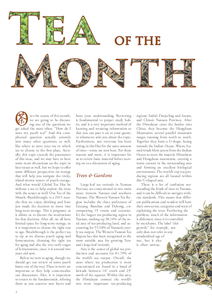 |
|

Over the course of this month, we are going to be discussing one of the questions we get asked the most often: "How do I store my puerh tea?" And this complicated question actually unravels into many other questions, as well, like where to store your tea or which tea to choose in the first place. Actually, this topic exceeds the parameters of this issue, and we may have to have some more discussions on the topic in later issues as well, but we hope to offer some different perspectives on storage that will help you navigate the tricky, island-strewn waters of puerh storage. And what would Global Tea Hut be without a tea to help explore the issue with the senses as well? Our Tea of the Month, Breakthrough, is a 2015 maocha that we enjoy drinking and have just made the decision to move into long-term storage. This is poignant, as it allows us to discuss the motivations for that decision. After all, we all have limited space for long-term storage, so it is important to choose the right teas to age. Breakthrough is the perfect tea to sip as we discuss puerh aging and fermentation, choosing the right tea for aging and also the very early stages of fermentation, since it is around two years old now.
Before we turn to aging, though, we should get our review of some puerh basics out of the way. These reviews are important as they help contextualize our discussions. Also, it is important to return to the fundamentals, refining them as you uncover new layers and hone your understanding. Reviewing is fundamental to proper study habits, and is a very important method of learning and retaining information so that you can pass it on to your guests, or whomever asks you about the topic. Furthermore, not everyone has been sitting in this Hut for the same amount of time - some are new here. For these reasons and more, it is important for us to review basic material before moving on to a discussion of aging.
Large-leaf tea varietals in Yunnan Province are concentrated in two main areas: western Yunnan and southern Yunnan. The Western Yunnan Tea Region includes the three prefectures of Lincang, Baoshan and Dehong, encompassing 19 towns and counties. It's the largest tea-producing region in Yunnan, making up 50.14% of the total area of tea-producing land, and accounting for 55.58% of Yunnan's yearly tea output. The Western Yunnan Tea Region has also been recognized as the most suitable area for growing Yunnan's large-leaf varietals.
Asia is the center of global tea production and accounts for 81.79% of the world's tea output. Overall, the areas where tea production is most concentrated are found in a band of latitude between 16° south and 23° north of the equator. Within this area, the Himalayas connect the world's two most important tea-producing regions: India's Darjeeling and Assam, and China's Yunnan Province. After the Himalayas cross the border into China, they become the Hengduan Mountains: several parallel mountain ranges running from north to south. Together they form a U-shape, facing towards the Indian Ocean. Warm, humid winds blow across from the Indian Ocean to meet the majestic Himalayas and Hengduan mountains, creating a warm current in the surrounding area and forming an excellent biological environment. The world's top tea-producing regions are all located within this U-shaped area.
There is a lot of confusion surrounding the kinds of trees in Yunnan, and it can be difficult to navigate without standards. This means that different publications and vendors will have their own terms, categories and ways of explaining the trees. Furthering the problem, much of the information is dishonest, since it is controlled by merchants. The label "oldgrowth," for example, not only does not refer to any standardized age of tree, but it also is often untrue.
There are way more cakes labeled "oldgrowth" than there is genuine oldgrowth raw material in the world, and by an order of several thousand times. At the Hut, we call tea "old-growth" when the trees are one hundred years old or more, and "ancient" when they get up near a thousand.

It is important to know that the size of the leaf does not help to determine if the tea is old-growth or not. Old trees still produce tiny, fresh buds, and small plantation trees also have large leaves. Tea in Yunnan is, after all, largeleaf varietals. This means that the trees are single-trunk, with roots that grow downwards; as opposed to small-leaf varietals, which evolved as tea moved north, naturally or carried by man. Small-leaf varietals have several trunks, with roots that grow outwards. Why the two categories are called "smallleaf " and "large-leaf " is because the leaves that are allowed to grow on the trees will be very different in size. In other words, you can pick small buds from either, but if the leaves are left on the tree, the large-leaf trees will produce much larger leaves, which can be bigger than a person's hand.
The issue is complicated, however, by certain so-called "dancing" varietals of large-leaf tea in Yunnan that branch right above ground into several trunks. It is also complicated by the fact that some farmers pollard their large-leaf trees. Pollarding means cutting the trunk so that it produces more trunks and then, the idea is, more leaves. There is, however, some research that proves that this doesn't really increase yield. Pollarding is obviously not the healthiest option for the trees. It is also done sometimes to make picking more convenient, but we would choose to refer to that as "pruning," to differentiate it from pollarding.
Another way of categorizing largeleaf tea is to call it "chou mu (喬木)," which means there is a single trunk, which grows up around a meter before branching. Though there are varietals of large-leaf that branch lower down, there is still always a thick trunk, so the separation can be useful. Smallleaf tea branches immediately, like a bush. (Again, the "dancing" varietals of large-leaf tea trees are an exception, though their trunks are still thick just beneath ground level.)
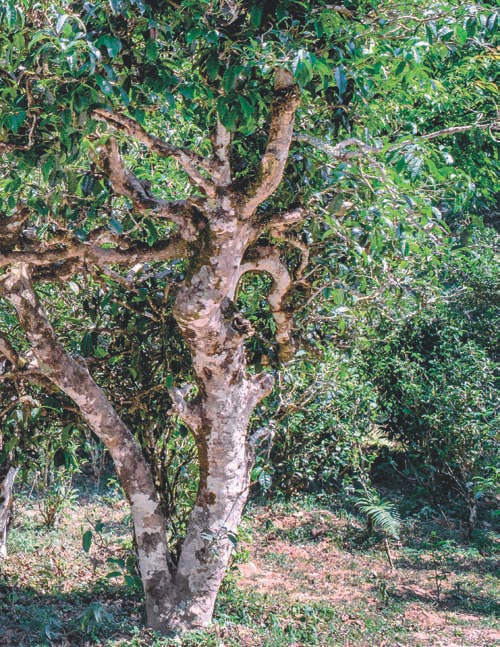
To determine the age of a largeleaf, chou mu tea tree, you have to look at the thickness of the trunk, not the height. Tea can grow tall very fast. Even in ten years a tree can be several meters tall. You determine the age by the thickness of the trunk. The girth of the trunk is also relative to the varietal, but, in general, real old-growth trees have thick trunks. If the trunk has a diameter of two hands, you can be sure it is more than one hundred years old, and certainly old-growth. Over time, as you see more trees, you will get better at determining their age based on appearance alone.
But every shop owner in China who sells puerh has photos on their phone of genuine old-growth trees that they are happy to tell you are the very trees that their tea is made from. Sometimes they even hang signs with their logos on the trees for the photo. This is very rarely genuine, however. Sadly, there is an ocean of plantation tea and only a small stream of genuine old-growth tea. Learning to taste and feel the difference will be paramount in your tea journey.
After the distinction between smalland large-leaf, it is important to understand the three kinds of tea gardens in Yunnan. Again, there is no standardization in this, so we have to create our own. Different authors and vendors, however, will describe and label these kinds of gardens in their own way. But once you have a basic understanding of these three, you will be able to navigate any discussion you have with a puerh lover or tea vendor about the kinds of gardens in Yunnan. We call the three kinds of gardens: plantation, eco-arboreal and forest.
Plantation tea is grown in rows, with tea propagated by cuttings all planted close together, usually in lower altitude, more accessible places, though plantation tea can be grown anywhere. The dangers of plantation tea are that this is where conventional farming is most predominant, which means the tea often is not organic and grown industrially. As such, this tea is rarely as healthy for people, and most certainly not for the environment. It also lacks sustainability. Such tea is not what we call "living tea." Living tea has six characteristics. (See the sidebox below.)
The other issue with plantation tea, as far as puerh goes, is that it is missing much of what makes puerh tea unique. There is little by way of processing that defines puerh (a lower temperature/lighter de-enzyming, sha qin (殺菁), and sun-drying, both of which contribute to fermentation). Puerh is more defined by the rich biodiversity of the forests of Yunnan; the glacial water that flows there from the top of the world (the Tibetan Plateau, which extends into northern Yunnan); the old tea trees which live longer and have deeper roots than most all tea, changing the medicinal qualities of the tea there; and, of course, the rich aboriginal cultural and spiritual heritage surrounding puerh tea. But all these factors are absent in plantation tea, which is made from smaller, younger trees, rarely in the forest, etc.
The second kind of garden, which we call "eco-arboreal," is composed of living tea planted or wild right near the edge of the village. The trees grow up in biodiversity and live in a healthy environment, but not in the forest. These trees are just outside the village, and sometimes surrounded by other agriculture. These trees are more convenient to care for and harvest, since the farmers do not have to hike to get to them. They are still quite happy and healthy, and, as of now, small Yunnanese villages aren't so bad to live just outside of, as many are still clean and in healthy balance with the environment. Not all eco-arboreal tea is clean, though. There is rarely ever any pesticide used with such tea, but some farmers do use weedkillers around the trees and/or chemical fertilizers to increase yield. In areas where these trees are surrounded by other crops, they can also be cross-contaminated, if the local farmers are using agrochemicals on those plants.
The final kind of garden is a forest garden. These can be wild or planted by people. These are gardens in the forest, often protected parks. The tea grows naturally, and in a full and natural ecosystem. Obviously, this represents the best of what puerh tea has to offer. Sadly, almost every puerh vendor in the world gives the impression that all his or her tea is of this variety, when very little of this kind of tea actually exists anymore. Many times you could hike into the forest and pass right by such a garden, if you didn't know what to look for, since the tea garden would look just like all the other jungle you had passed by on the way there. These natural, forest gardens are what "bring Nature to society." This is where the sounds of the forest can be found in the bowl.
Getting to know these kinds of tea and learn how to tell if the tea is really old-growth, and what kind of garden it comes from, is helpful, but also remember that, in this tradition, we have a saying, "as the person seeks the Leaf, the Leaf seeks the person." Much of what kind of tea finds us will have to do with our approach to tea, our relationship to the Leaf and how we serve it to others as well. Our heart will guide us to the right teas, just as the right teas will find the people with heart. When you respect Tea as medicine, and are committed to protecting the aboriginal culture and environment old-growth forest tea grows in, such tea will find you. Like we say, "as the person seeks the Leaf, the Leaf seeks the person."
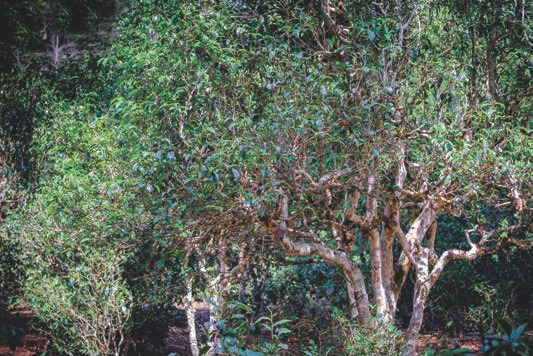
Living tea has six characteristics:
A lot of tea and other agricultural products produced these days are like goldfish or poodles, in that the trees cannot survive on their own. Because they are irrigated, they never learn to grow deep roots and drink the mountain water; and because they are fed by fertilizer shipped in by humans, they are not grown on the mountain minerals and nutrients so important to the quality of tea (and the health of any organism). The health and quality of a tea is more in its terroir - environment, soil, climate, etc. - than any other factor.
When the tree is grown sterilely and not permitted the breadth to grow strong and independent, so much of the quality and characteristic uniqueness of the tea is lost to sterile, industrialized uniformity of cloned, flat and lifeless tea leaves and liquor.
That said, there is also a need for agriculture that compromises some of these characteristics to increase yield, not out of greed but because there are more tea lovers than healthy tea trees. Still, whatever compromise we make to increase yield, we cannot do so in an unsustainable way or future tea lovers won't have tea. For that reason, agrochemicals are out of the question.
All puerh comes from Yunnan, the birthplace of tea. There are two kinds of puerh: sheng and shou. Sheng is the more traditional, greener kind of puerh. It is picked, withered, fired and sun-dried. Sheng tea is then naturally fermented over time, and the older the better. It miraculously mellows from green, powerful, astringent tea to deep and dark elixirs. It also changes from "cool" to "hot," in the Chinese medical sense of the words. Shou tea goes through an additional step, after the ordinary steps listed above. It is piled under thermal blankets, in order to artificially ferment the tea. Traditionally, aboriginals in Yunnan had many ways to turn their tea to warm (again, in the TCM sense),
including baking, roasting, or even burying it in bamboo. However, the modern method of piling the tea was developed and then commercialized in 1973 by big puerh factories, in an attempt to reproduce the amazing effects that time, and natural fermentation, have on tea. Of course, they only succeeded in inventing a new genre of tea, rather than actually achieving what nature does over such long periods of time. Succinctly, the difference is that sheng puerh is left green, which means it ages naturally over time (which takes seventy years to reach full maturity) and shou puerh is artificially fermented in piles (which takes forty-five to sixty days to fully ferment the tea). This month's tea is a sheng tea: picked, withered, fired and sun-dried. It dates to the year 2004 and is from the Yiwu mountain region.The most distinguishing steps in puerh production are the sha qing (killgreen) and sun-drying phases. The firing, or "sha qing," comes after withering. It is done to arrest the oxidation begun in the withering and to "kill" certain enzymes in the tea that make it bitter, which is why it may also be translated as "de-enzyming." In puerh tea, the de-enzyming is done at a lower temperature for a shorter duration, because some of these enzymes are important for the fermentation of the tea, which happens post-production (either naturally or artificially). This also ensures that heat-resistant spores will survive and flourish, as the bacteria and mold are the source of the fermentation. The sun-drying also facilitates and encourages fermentation by reactivating the microbial worlds that live in the leaves, going about their days in Horton Hears a Who style.
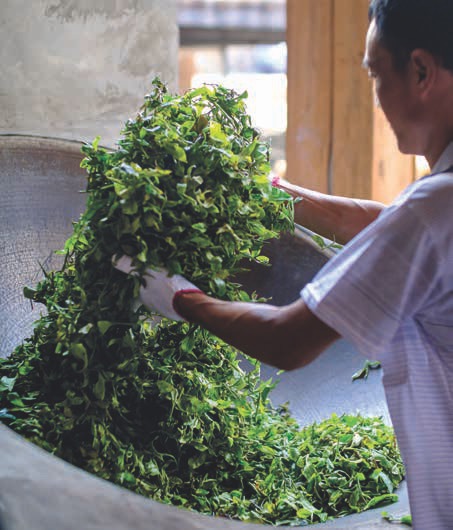

Sheng puerh made from old trees is typically only harvested in the spring, with the occasional buds in autumn as well. Old trees need to be left to their own devices to produce living tea. Using fertilizers or hormones to increase production will upset the natural equilibrium of the tree's ecological relationship to the soil, mountain and weather, and the trees will eventually die from such farming.
The harvested leaves are withered, indoors and out, fried to kill green enzymes and arrest oxidation, rolled and then sun-dried. The two identifying features of puerh production are the frying and the sun-drying. The frying of sheng puerh is done at a lower temperature and for a shorter time than other kinds of tea. This leaves some of the bitter, astringent enzymes alive and active, which aids in the fermentation of the tea over time. The sun-drying also helps activate the fermentation, exposing it to the bacteria that will help in that process. In fact, the relationship that puerh has to microbial life is one of the main characteristics that define this genre of tea. At this point, the tea is called "rough tea (毛茶, maocha)," which means that it is essentially unfinished. Such tea is then pressed into cakes, sometimes blended with teas from other regions. In modern times, this is done at factories rather than at the mountain where the tea is harvested/produced, but traditionally the compression and finishing was also done on the mountain, using the same water to steam the tea into cake form as it drank when it was a part of the old tree, which is obviously ideal. This also means that, as it is being compressed, it will be exposed to its native bacteria.
Puerh processing is a very old and simple methodology. Different genres of tea have different measures of quality, based on a ratio of raw material to processing skill. Cliff Tea, for example, is measured at least as much in the processing as it is in the trees/leaves. But puerh is different. With puerh, the quality is much more in the trees/ leaves, with tea from older trees having more breadth, wisdom and medicinal juju. Mountain, location and age of the trees will all play a large role in the price and quality of a puerh. Because of that, there is a lot of confusion and dishonesty surrounding regions and age of trees in the puerh market, with young, plantation-tree tea (tai di cha) being mixed into old-growth raw material, or tea from one region being brought to another and sold under false pretenses. This means that you have to have some experience tasting teas, knowing if it is organic or not, young or old-growth, and from which region (at least relatively). It also helps to have trusted sources, like we do at the Hut.
Nowadays, there is also a lot of confusion about blended versus single-region tea, as well as what defines "old-growth" puerh. It is good to have some clarity on these issues, at least in terms of what we are writing about in the pages of Global Tea Hut. As for the first issue, there are great blended teas from the Masterpiece (1949 - 1972), Chi Tze (1972 - 1998) and Newborn (1998 - present) eras of puerh. Sometimes, teas from different regions, or even the same region, enhance each other beautifully. All teas are technically blends, since different sides of the same tree will produce different leaves, let alone different parts of the same forest. Still, there is something to be said for single-region puerh since that was the way that all puerh tea was traditionally produced. All the teas from the Antique Era (pre-1949) were single-region. The terroir of a place, including the culture of how to process the tea, will then be homogeneous. This includes the genetic heritage of the trees, the climate and soil, the microbial environment so important to the tea's fermentation, and ideally also the spiritual/cultural rituals that surround harvest and production. As for what we mean when we call a puerh "old-growth," for us it means that the tea leaves were harvested from trees that are at least one hundred years old. We think that when you start talking in centuries, it's definitely "old-growth."
When drinking fresh-from-the-farm maocha, there are many criteria for finding the right tea to make into cakes: you can drink with an eye towards aging the tea (in which case, you will have to have had a lot of experience drinking aged and aging teas at various stages), learning about regions or creating cakes that can be enjoyed young. The best of teas will be great when young, middle-aged or vintage.
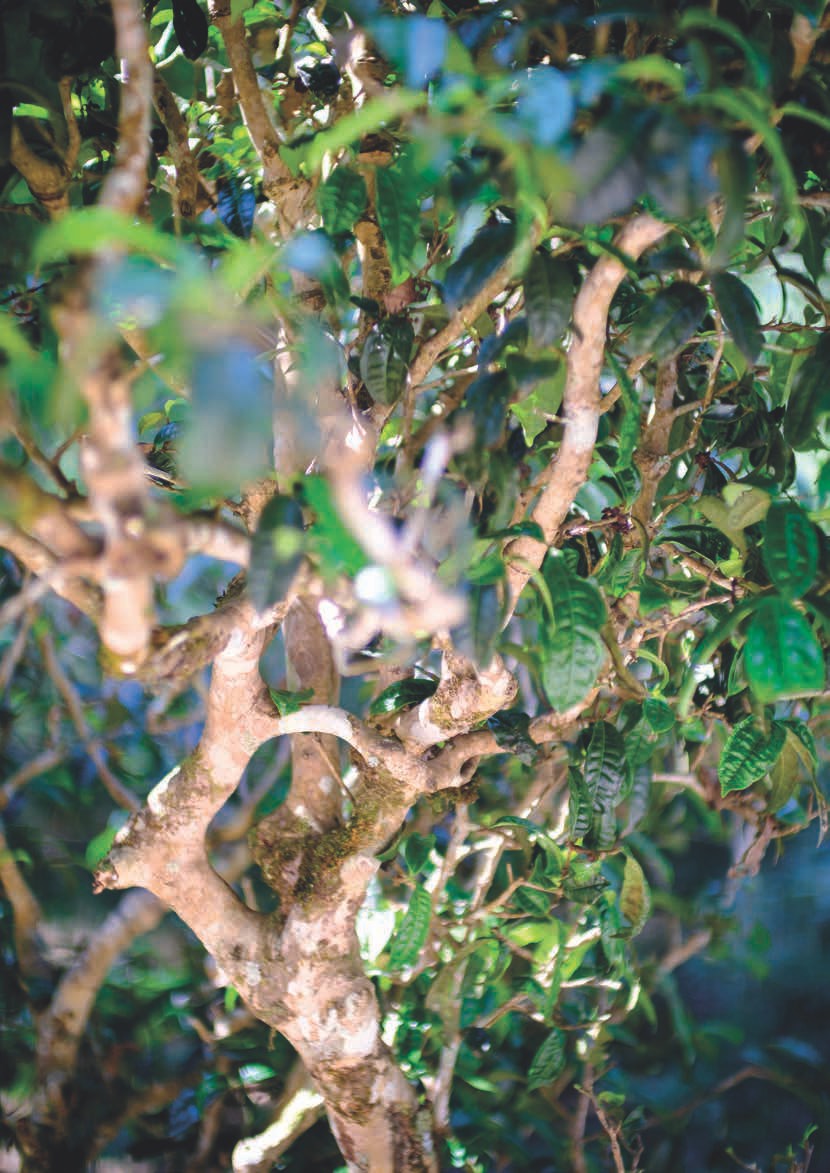
You may be wondering what Breakthrough has to do with aged or aging puerh. This tea is actually a wonderful opportunity to explore the issue. In Wu De's article on how to choose a sheng puerh for storage, he talks about which sheng tea to start the journey and also about tasting the tea at different times to make the final decision. For us, the two most important times to determine whether or not a tea is a good candidate for long-term storage are when the tea is new, and when it is two or three years old and starts showing the first signs of aging. Sometimes, this stage is more important for the final decision than the new tea.
Breakthrough is an autumn 2015 tea from Mengku (勐庫). Mengku is located in the Lincang city area, on the banks of the Lancang River, in Yunnan Province. The area is crisscrossed by mountain ranges, with a unique climate and abundant natural resources. Since ancient times, it has been famed for producing exceptional tea. The community of wild tea plants that grow at the Mengku Garden on Daxue (Big Snow) Mountain in Lincang form the highest altitude and most densely growing community of large-leaf trees discovered to date. The main peak of Daxue Mountain rises to 32-33 meters above sea level; the community of old tea trees are distributed over an area of around 800 hectares, situated halfway up the mountain, between 2200 and 2750 meters in altitude. Here, the average annual temperature is below 11 °C, with yearly rainfall averaging around 2000 millimeters. These heaven-sent natural conditions create a veritable paradise for tea plants.
For a long time we have intended to store some loose-leaf autumn sheng puerh for ten to fifteen years to see what happens. We have some autumn cakes in storage, but no autumn maocha that we know conclusively to be autumn tea. As we will discuss later in the issue, autumn tea is not usually as strong or vibrant, and is therefore not often the best candidate for long-term storage. Breakthrough was a great, rich and vibrant tea from nice, organic eco-arboreal gardens and available at the right price as well. But would it age well?
This bright tea is a kind of test for us all to do together. As you progress in your understanding of puerh tea, you must learn to also evaluate sheng puerh in terms of its ageability. This is, of course, important when choosing a fresh sheng tea, but also after two or three years, and then again around seven years. Just because a tea is nice for drinking doesn't mean it is a great candidate for long-term storage. Breakthrough is a wonderful tea to enjoy, but the question is whether or not you would continue to age Breakthrough. Is it a good candidate for long-term aging? What do you think? Let us know via email or through social media.
Whether or not you choose to participate in this experiment, and learn how to judge the ageability of a puerh, you should still take the time to enjoy Breakthrough as well. This tea is rich, hovering between fresh, green sheng and slightly aged tea. It was stored pretty dry so far, so it is on the greener side of a two- to three-year-old Sheng.
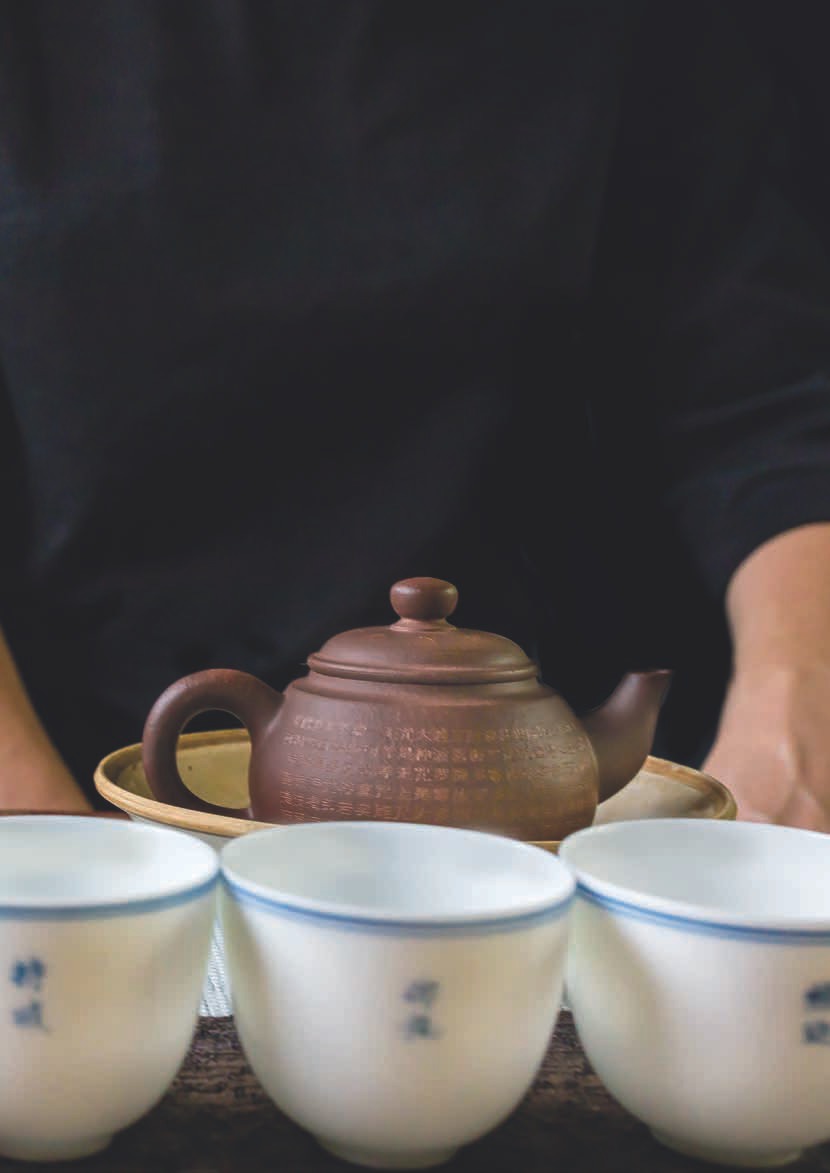
If you are going to try to evaluate this tea for aging, we would recommend gongfu brewing. Otherwise, this tea will be nice as either leaves in a bowl or in a sidehandle as well. We have filled the can a bit higher this month, so if there aren't too many guests at your session, you could even try more than one method - perhaps evaluating the tea for aging in one session and just drinking for pleasure in another.
This month, we want to hone in an aspect of tea brewing that is so subtle, you may not have thought too much about it before now: the height and speed of your pour. Of course, the differences in how quickly you fill the pot and from how high the stream pours will be more influential and easily recognizable in gongfu tea. Also, bowl tea is more about ceremony and meditative space, and not really conducive to experimentation. That said, how you fill a sidehandle pot, and from how high, also can change the experience of the tea. And while we wouldn't recommend experimentation or focus on quality in bowl tea - since it is about creating sacred space, that doesn't mean the brewer cannot apply some simple techniques to also improve her guests' experience of the tea on a sensual level, including the way the water is poured.
As this topic is bigger than this section of the magazine allows, we want to focus specifically on a puerh tea like our Tea of the Month. Puerh actually responds better when the water is poured quicker and from lower down, with as large and fast a stream as possible. If you are brewing Breakthrough gongfu, we recommend taking the time to experiment a little. Try steeping one brew in which you attempt to fill the pot more quickly and from lower down, and another where you pour a thinner, slower stream from higher up, and see if you can tell the difference. If you wish, you can use the Ten Qualities of a Fine Tea to evaluate the two cups.
Of course, the height and speed of your pour from the kettle also affects the temperature at which the leaf steeps, and so a lower, faster pour results in hotter water, which is conducive to mostly all puerh tea, since it has thicker, tougher leaves that can take a stronger heat. As we have often discussed in previous issues of this magazine, your journey in tea brewing is one of understanding heat, water and leaves, not to mention the other elements. Tea brewing is an alchemy of all five elements (earth, water, wood, fire and metal) as well as a concordance of all our senses with Nature, utilizing each sense to prepare and enjoy the tea.